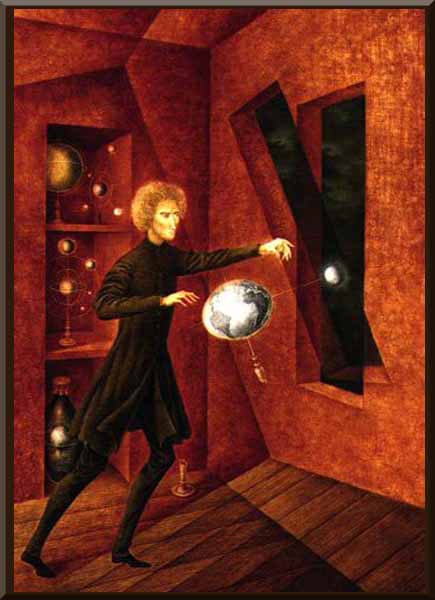Remedios Varo: Phenomenon of Weightlessness
1963
FromThe Science Of Remedios Varo
Excerpts from The New York Times-Science Forum
A man, presumably a scientist, stands in a room with a number of orreries on shelves. One orrery, of the Earth and Moon, has broken free of its base and floats in the air. In addition, the room is duplicated and shown superimposed over the original, but at an angle of 30 degrees. This room is the special theory of relativity made real, or surreal. To depict the so-called Lorentz equations, which are at the heart of Einstein’s revelation, one would draw a standard graph with X and Y axes, and then rotate the graph 30 degrees to show how time and space shift for different states of motion.
The scientist is described as looking frightened, because the world is shifting under his feet,but in fact he’s absolutely engrossed with every fiber of his being. This isn’t something that happened to him; he invented it. He sees that there is another way of treating gravitation, and he’s astonished that he’s come up with the idea. He’s also a little fearful, because you can never be sure your idea will be right, but this is his own creation he’s dealing with. The figure in “Phenomenon” even has wild Einsteinian hair, still youthfully brown, for Einstein was only in his 20’s when he conceived of special relativity.
Born in Spain in 1908, Ms. Varo came by her interest in science patrilineally. Her father was a hydraulic engineer who encouraged his daughter’s early display of artistic talent but drilled her in the rigors of draftsmanship and the correct use of the rule, carpenter’s square and triangle. She studied art in Spain and France and became immersed in the Surrealism movement. Fleeing the Fascists and the Nazis, she found her way to Mexico, where she married Walter Gruen, an Austrian emigre who made a small fortune and told her, “If you want, all you have to do is paint.” Paint is what she did, creating large, intricate canvases using a brush with only three bristles.

